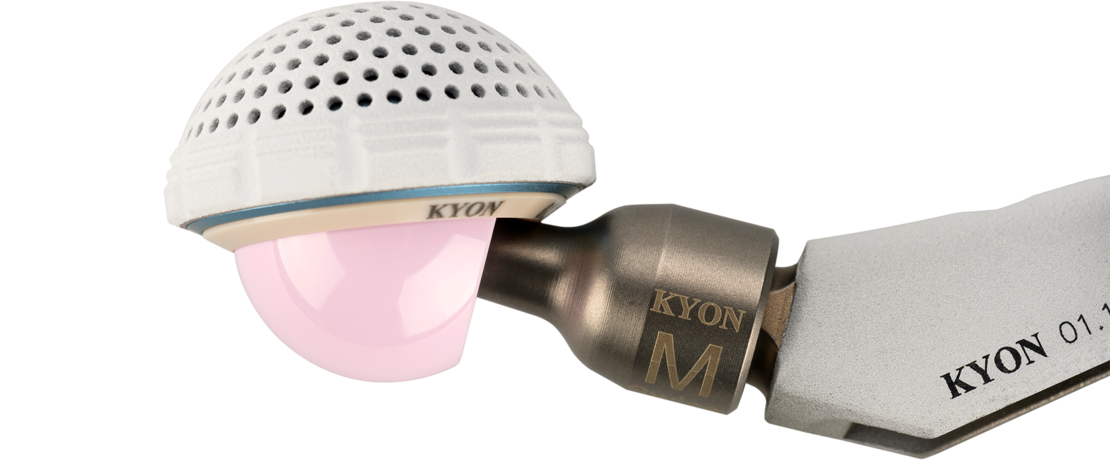 Evonik is exploring the possibilities of using the high-performance polymer VESTAKEEP® PEEK, a proven implant material for medical technology, for complex joint prosthesis systems.
Evonik is exploring the possibilities of using the high-performance polymer VESTAKEEP® PEEK, a proven implant material for medical technology, for complex joint prosthesis systems.
Collaboration with the Harris Orthopaedics Laboratory at the Massachusetts General Hospital in Boston, USA
Transfer of innovation from veterinary to human medicine
Partner search for further development steps
Evonik is exploring the possibilities of using the high-performance polymer VESTAKEEP® PEEK, a proven implant material for medical technology, for complex joint prosthesis systems. The specialty chemicals company is drawing on the expertise of medical specialists at the world-recognized Center for Knee and Hip Replacement at Massachusetts General Hospital in Boston (USA). If the innovation succeeds, the service life of VESTAKEEP® based joint prostheses could be significantly extended, consequently reducing revision surgery or years of pain therapy. The success of PEEK-based hip prostheses in veterinary medicine from the Swiss company KYON supported Evonik's innovation approach.
PEEK as a material component in joint prosthesis systems
Joints are complex movement systems that fulfill important anatomical functions and are constantly exposed to heavy stress. At the Medical Device Competence Center in Birmingham, Alabama, Evonik is pursuing the approach of analyzing the weak points of the joint prosthesis systems already established on the market in human medicine and developing a solution with its high-performance PEEK polymer.
"We are looking into the use of VESTAKEEP® in human joint prostheses to improve the quality of life for patients," explains Marc Knebel, head of the Medical Systems market segment at Evonik. "For example, we have learned to understand PEEK as a material component in complex joint prosthesis systems that can be integrated into existing technologies according to the modular principle.“
Extending the life of joint prostheses fourfold
Today's joint prosthesis systems are convincing in terms of availability and reliability. However, friction partners - so-called inlays such as those between the head and the cup of a hip prosthesis anchored in the bone - are a primary weak point of current technologies. "Our tribological PEEK biomaterial could make the decisive difference in the future and extend the service life of a hip prosthesis fourfold," says Knebel
If it were, millions of patients worldwide could do without years of pain-relieving therapies. These are often necessary to reach a certain age for surgery, so that the probability of a risky revision at an advanced age can be reduced.
"The regulatory approval process in human medicine is strictly oriented towards added value for patients. We have to provide sufficient evidence of this added value to attract partners for further development steps. For this reason, we cooperate with Massachusetts General Hospital in Boston, test our material for tribological properties in their professional laboratories and receive valuable feedback that always takes us one step further," Knebel says.
Orhun K. Muratoglu, PhD, Director of the Harris Orthopaedics Laboratory and Director of the Technology Implementation Research Center (TIRC) at the Massachusetts General Hospital in Boston and Professor of Orthopedic Surgery at the Harvard Medical School comments: “At the Harris Orthopaedics Laboratory we used our state-of-the art in-vitro wear testing machines to evaluate the performance of medical grade PEEK formulations for orthopedic joint replacement applications such as hip and knee implants and found that UHMWPE-PEEK pair has similar or better performance than that of the gold standard UHMWPE-CoCr pair.”
Innovation scenario from veterinary medicine
Evonik's PEEK biomaterial is already being used successfully in the latest generation of hip prosthesis systems for pets such as dogs and cats from the Swiss company KYON. At the heart of the innovative technology is a friction partner made of Evonik's VESTAKEEP® PEEK biomaterial with an additional carbon-fiber-reinforced PEEK ring between the ceramic head and the cup. Unpublished data indicate that linear wear is reduced by a factor of 7 with ceramic on PEEK compared to conventional pairings.
Approximately 6000 successfully performed hip replacement procedures without a single revision due to inlay wear and just as many satisfied dogs - including true champions (agility dogs) - as well as five years of careful documentation confirm the success of KYON's PEEK-based hip replacement system. Among other things, Evonik's polymer experts would like to transfer the material expertise and application understanding from veterinary applications with potential medical device manufacturers to human medicine.
www.evonik.com


















































































